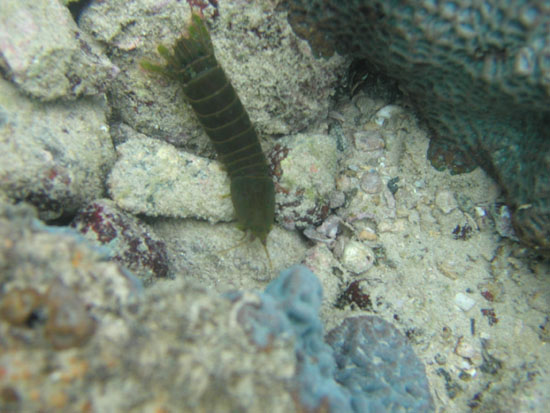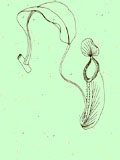
 |
Invertebrates (pdf)
A photo record of the coral reef mantis shrimp, Pseudosquilla ciliata in Hong Kong
1 International Elite Divers Training Centre, Ltd.
There is virtually no documentation or record of coral reef associated Stomatopoda (i.e. mantis shrimps) in Hong Kong, as most local studies on stomatopod Crustacea have been conducted in deeper waters (i.e. >20 m in water depth) using shrimp trawlers (Lai et al. 2003). On 18 May 2003, Ming-Hong Cheung and Joey Leung were diving at the south of Shelter Island, Port Shelter, Hong Kong (Grid reference: 22° 19’N 114° 18’E; water depth: ca. 8 m and visibility: 10 m) where they discovered and photographed a greenish mantis shrimp walking across the coral reef area (Figs. 1 & 2). The total length of this stomatopod was ca. 100 mm estimated by the divers. It could move very fast on the seabed and was occasionally hidden under the sediment or reef structure.
 |
 |
| Figs. 1 & 2. The coral reef mantis shrimp Pseudosquilla ciliata found at Shelter Island, Port Shelter. |
Recently, these photo records have been sent to the leading authority of Stomatopoda, Dr. Shane T. Ahyong of the Department of Marine Invertebrates, Australian Museum for further identification. The photographed stomatopod is confirmed to be Pseudosquilla ciliata (Fabricius, 1787) by Dr Ahyong. Probably, it is the first record of this reef stomatopod species in Hong Kong waters. This is a widespread coral reef species, which have been found in Australia, Vietnam and Indo-West Pacific (Ahyong 2001). Due to its wide occurrence throughout the region of South East Asia, it is not surprising that P. ciliata also inhabits in the coral reef area of Hong Kong. Although this photographed specimen is green in colour, it is important to sound a note that the colour of the species is amazingly variable and can vary from lemon yellow to mottled green or brown to black-green; they can change their colour dramatically between moults (Ahyong, personal communication). Detailed information regarding the morphology and identification of this species can be found in Ahyong (2001).
This is, once again, a good example to illustrate how much we still don’t know about the diversity of marine life in the marine environment of Hong Kong. In future, more studies should be carried out with a view to deepening our knowledge about the diversity and ecology of reef Stomatopoda in Hong Kong.
Acknowledgements
The authors are very grateful to Dr Shane Ahyong for species identification and invaluable information about this reef stomatopod species.
Bibliography
Ahyong, S.T. (2001). Revision of the Australian Stomatopod Crustacea. Records of the Australian Museum, Supplement 26. 327 pp.
Lai, C.H., Tsui, J.C.Y. & Leung, K.M.Y. (2003). Distribution and demography of Stomatopoda in the subtidal marine environment of Hong Kong. In: Turning the Tides - A Festschrift in Honour of Professor Brian Morton, (ed. P.K.S. Shin), The Marine Biological Association of Hong Kong, Hong Kong. pp. 159-183.
|
|
P.8 |
|
Porcupine! |
 Copyright © 2000 |
